Since the time of the great Greek historian Herodotus, the Seven Wonders of the Ancient World has caught the imagination of people all over the world. In modern times, the symbolism got rekindled with the choice of seven modern man-made wonders of the world, followed by natural ones, and other categories of objects on the Earth’s surface. When I read a recent article on the theme, my interest was fired, and I wondered why we shouldn’t be thinking of seven wonders of the night sky.
The inauguration of the Hanle Dark Sky Reserve (HDSR), followed by the Hanle Star Party last October where Neelam and I were participants, my interest got focused on identifying my own list of seven wonders of the night sky, specific to the HDSR, a unique facility in the world for night sky observations for both professionals and serious amateurs. Here is the outcome of this exercise.
The Hanle Dark Sky Reserve (HDSR) is probably the most wondrous place in India to watch the night sky in all its glory. The HDSR combines high altitude as well as remote location far from any city, dry atmosphere, negligible lights and other pollutants. It showcases the night sky like nowhere else in India.
A night spent at the HDSR out in the open would certainly etch an indelible memory of celestial jewels in your mind for the rest of your life. You would think that you would have to carry along some sophisticated optical instrument to see the night sky. On the contrary, a visual observation with just your naked eyes would show you some of the rarest phenomena and beautiful happenings in the night sky. Lie down on a recliner at night, and be one with the universe at the HDSR.
However if you carry a binocular or a telescope along then you are in for a special treat of the deep marvels of the night sky. You could also opt to meet one of the ‘Astronomy Ambassadors‘ of HDSR. The Astronomy Ambassadors are provided with telescopes and are trained to locate a variety of deep sky objects for your viewing pleasure.
Here is my select list of the seven most wondrous phenomena, rare happenings and beautiful celestial objects that are visible when you are in the HDSR. A brief description follows each of the seven wonders of the HDSR night sky. The wonders are listed in reverse order of attractiveness as perceived by me.
The criteria for a phenomenon making to this list is that you must be able to see with your naked eyes. The other requirement is that they should be rare enough to be visible from HDSR and not every place else.
7. Venus in Daytime

It is easy to observe Venus in daytime at the HDSR with the unaided eye since it is the brightest planet, and the sky of HDSR is clear of all pollution and haze. Venus’ completely cloudy surface reflects 69% of the sunlight hitting it. It is the third brightest object in the sky after the Sun and the Moon. When Venus is at its brightest phase, it shines 25 times brighter than the brightest star, Sirius. It is at its brightest when its phase is thick crescent, 35 days before or 35 days after its inferior conjunction with the Sun.
All this means that Venus should be easily visible to the naked eye at the HDSR. You will only have to know the direction of the planet in the sky. You must be careful to avoid looking towards the Sun while locating it. Check the elongation of Venus from the Sun using a smartphone app like Daff Moon. Do not try to observe the planet if it is close to the Sun, when the elongation is less than 25°.
To locate Venus, you can use an app in your smartphone such as Stellarium, Sky Map, Sky View, Sky Safari or anyone of the numerous other apps. You need to point the phone towards the sky to locate Venus. These apps also have a search facility to locate any celestial object.
On certain dates the Moon is close to Venus, and you can locate the Moon in the daytime sky and then move your gaze in the appropriate direction to locate Venus. It would tremendously help if you stand in shade, or against a wall, just to hide the Sun and its glare in your eyes.
6. Pleiades and its nebulosity, Hyades
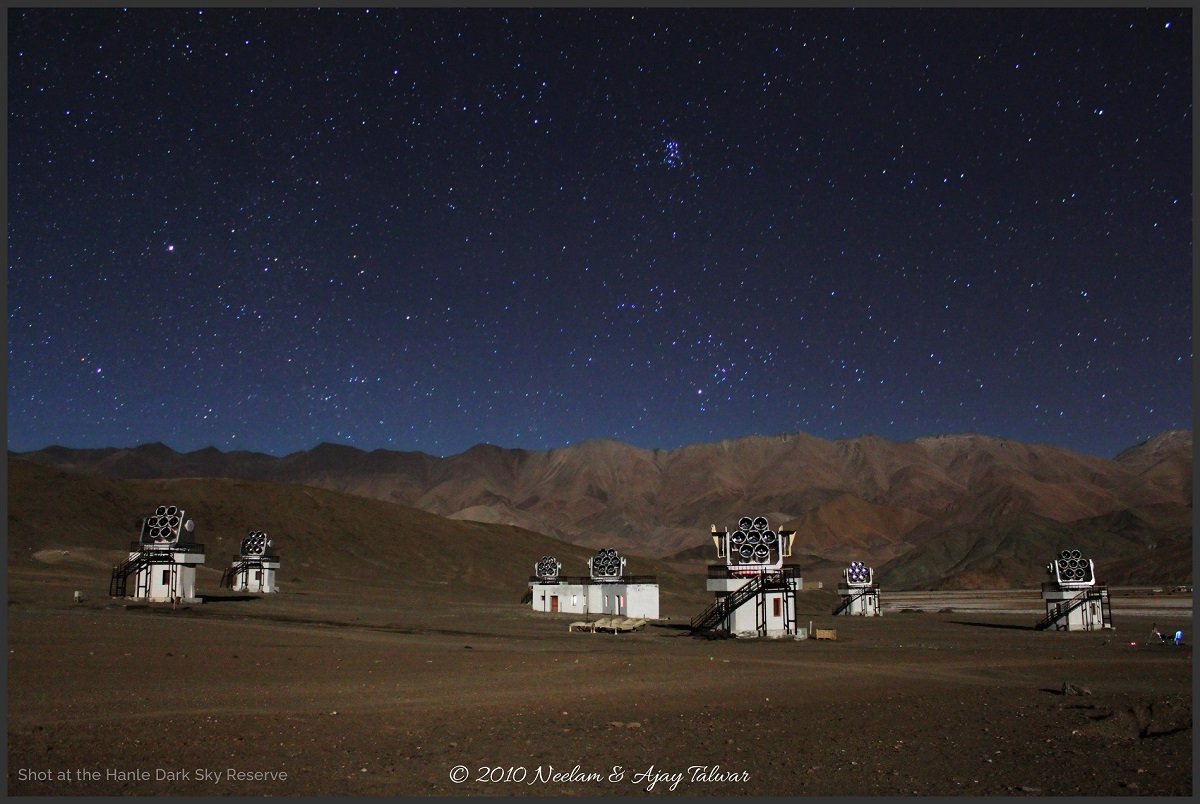
It is known as Krittika in India, Subaru in Japan. It is also known as Pleiades to the Greeks and popularly known as Seven Sisters all over the world. Every ancient culture has seen and recorded this heavenly object. You must surely have seen it yourself, this beautiful cluster of stars in the night sky, as it is visible even from the cities easily. It is a beautiful sight when it rises over the eastern sky, followed by another large cluster in constellation Taurus, the Hyades. Together, Pleiades and Hyades make a wonderful part of the night sky with bright stars.
But what is special about Krittika to be included in this list of Seven Wonders at HDSR? In the clear night sky of the HDSR you will be able to glimpse the nebulosity in the Pleiades, just about discernible with your naked eye. Here is a ‘glittering little swarm of stars’ memorialized in Alfred Lord Tennyson’s poem Locksley Hall:
Many a night I saw the Pleiades,
risin’ thro’ the mellow shade
glitter like a swarm of fireflies
tangled in a silver braid.
The ‘swarm of fireflies’ refers to the many stars of the cluster, and ‘tangled in a silver braid’ probably refers to the nebulosity surrounding the stars. The nebulosity would be better seen with a pair of binoculars
5. Earthshine above Hanle Mountains (just Earthshine, Moon hidden)

In the couple of days before New Moon of any month, there is a wonderful event that you could plan for. About 3-5 days before the New Moon, the Moon is crescent shaped and rises before Sunrise. You can check the time of rising of the Moon using one of the apps in your smart phone. I generally use ‘The Photographers Ephemeris‘. The app will take the location coordinates from the inbuilt GPS and show the rising time, but the rising time is for the theoretical horizon, 0° altitude. All around the HDSR there are mountain ranges. The height of the mountains varies from 3° to 7° above the theoretical horizon. Moon will take some extra time to rise further and be visible above the mountains. The exact time of rising above the mountains can be seen in another smartphone app called ‘Peakfinder‘. The app will even show you the profile of the mountain, and you will know the exact spot that the Moon will rise from, as well as the exact time.
Be fully awake and ready at the appointed time at dawn. It is no doubt a ‘dawnting’ task to be up so early in the cold temperatures of HDSR and await the mesmerising sight.
You will see the earthshine portion of the Moon, the ashen light, appear first. As the Moon keeps on rising for a full minute or more, you will keep on seeing the Earthshine. It is a scene that you want to continue seeing for a long time. Eventually the sunlit portion of the Moon rises, the horns on the two sides appearing first, and then the entire crescent coming up.
If getting up so early before sunrise scares you, then you can see the reverse phenomenon in the evening, towards the western direction. A few days after the New Moon, when Moon is in the crescent phase, the sunlit portion will set first and thereafter the earthshine will slowly sink behind the peaks. Whether you see this phenomenon at dawn or dusk, it will remain in your memory forever. Of course you would want to photograph this too. My advice – use a 200 mm lens mounted on a tripod. You could choose to click a single image or make a short movie.
4. Milky Way crossing the Zenith, Cygnus Rift

Standing under the clear sky at the vast open arena of the HDSR, on a moonless night in September, we can trace the path of the Milky Way across the entire heavens, as a wide glowing band, from the Perseus-Cassiopeia region, in the northeast, up through the bright star clouds of Cygnus, at the zenith, and thence southwards through Aquila and Scutum, to the culminating splendour of Sagittarius above the southern horizon. Brilliant Vega sparkles nearly in the zenith, and white Altair approaches its culmination high in the south; between these two stars we can follow the course of the “Great Rift” which now begins to divide the Milky Way into two parallel streams all the way to the southern horizon. The Rift is the dark band of dust clouds obscuring the bright galaxy behind.
The 11th Century Sung Dynasty poet Su T’ung-Po, while contemplating the silent circling of the stars and the majestic panorama of the Celestial River, writes:
It is nightfall; the clouds have vanished;
The sky is clear, pure and cold …
Silently I watch the River of Stars,
Turning in the Jade Vault…
Tonight I must enjoy the life to the full.
You have seen numerous images of Milky Way, all over the social media, websites and everywhere, and have often wondered, “Is the Milky Way ever visible with the unaided eyes?”
Yes, most certainly at the HDSR. Travel to this dark sky reserve, in the months from June to September, and you will be rewarded by the sight of the Milky Way spanning the sky from horizon to horizon and passing through the zenith. Although the Milky Way is visible in the entire summer season, here are some indicative timings when the Milky Way would be crossing the zenith: June 1 – 3:30 am; June 15 – 2:35 am; July 1 – 01:40 am; July 15 – 01:50 am; August 1 –11:30 pm; August 15 – 10:45 pm; September 1 – 09:40 pm; September 15 – 08:40 pm.
3. Gegenschein

Is the night sky darkest in the direction opposite the Sun? No. In fact, a rarely discernible faint glow known as the Gegenschein (German for “counter glow”) can be seen 180 degrees around from the Sun in the extremely dark sky of the HDSR.
Imagine the particles of 1 mm in diameter and on an average separated by 8 km, forming a low density of dust cloud coincident with the plane of the Solar System, and constantly regenerated by dusty comets roaming in the Solar System. This small cloud produces the elusive phenomenon called Gegenschein by reflecting sunlight. It forms a slightly brighter elliptical spot of 8–10° across directly opposite the Sun within the dimmer band of zodiacal light.
A clear night without moonlight is quite necessary for viewing the Gegenschein. The faint light will always be visible in the zodiacal constellation that is exactly opposite to the Sun. If there is a bright planet in opposition, such as Jupiter, or Saturn, it will be difficult to see the Gegenschein. Dark adapt your eyes fully, with no nearby lights and use ‘averted vision’ to locate this extremely elusive glow from the Solar System itself.
2. Galactic Centre in Sagittarius, Dark Horse

The biggest attractor of visitors to the HDSR would certainly be the Milky Way in Sagittarius towards the galactic centre. The Galactic Centre is visible throughout the summer season, and well into the autumn, towards the southern direction.
Looking towards the Sagittarius Star Cloud, we are looking across some 300 light centuries of space, towards the centre of the Galaxy. The region is truly fascinating area for exploration. These magnificent star clouds are the finest in the sky. They are full of splendid details. Bright cluster of stars, nebulae and dark regions are quite easily visible to the naked eye.
One of the largest and darkest dark nebulae in the summer sky lies midway between the Small Sagittarius Star Cloud (M24) and brilliant Antares in Scorpius. The nebula is so large that astronomer Barnard assigned it five separate entries in his catalogue. By eye, we see them collectively as the Pipe Nebula. The Pipe Nebula is actually quite obvious when viewed at the HDSR, but by adding other, more subtle dark patches that float to the Pipe’s northwest, the area transforms into the profile of a horse. In fact, the horse even seems to be strutting or prancing, as you might see in a circus act.
1. Zodiacal Light

The Zodiacal Light has to be the most wondrous phenomenon that is visible at the Hanle Dark Sky Reserve (HDSR). Google the words ‘Zodiacal Light’ and you will find definition and description, which will always mention ‘A faint diffuse glow produced by the sunlight reflecting from the dust and particles in the Solar System’. After you have witnessed the Zodiacal Light at Hanle, you will doubt the veracity of this definition because the light is so bright and so easily seen at the HDSR’.
The HDSR is particularly suited to observe the Zodiacal Light. The area is dark, free of light pollution, the atmosphere is rare and clear. Additionally, the HDSR lies at a latitude of 33° and the ecliptic stands fairly vertically above the horizon, making the Zodiacal Light prominent and easily visible. Since it is produced by the dust in the Solar System, it is always seen in the zodiac constellations, along the ecliptic.
Zodiacal Light is shaped like a triangle above the horizon, and the apex of the triangle is always aligned with the ecliptic. The brightness of Zodiacal Light is comparable to or sometimes even brighter than the Milky Way, especially towards the horizon.
At HDSR the best period to see the Zodiacal Light after the evening twilight would 2nd and 3rd week of March. Sunset would be about 18:15, and the Zodiacal Light would begin to be visible around 19:35 as a triangular glow towards the West. The ecliptic is almost perpendicular to the horizon around this time, and the Zodiacal Light would be seen in the constellations of Pisces, Aries and Taurus.
When the Zodiacal Light is seen in the morning hours it is also known as the ‘False Dawn‘. The Best period to see the False Dawn before morning twilight would be the middle of September. Astronomical Twilight would begin at about 04:30. False Dawn would be brightest just before Astronomical Twilight, in the constellations of Leo, Cancer and Gemini. Zodiacal Light is always triangular shaped. and as Astronomical Twilight signifies the arrival of the (real) dawn, the light of dawn would be spread horizontally along the eastern horizon. False Dawn is a light which is coming from the Solar System, and dawn is the light falling in Earth’s atmosphere.
Here is a poem titled ‘Zodiacal Light’ by Albert Laighton:
After the twilight dies,
In the distance vague and dim,
While Hesperus still like a jewel lies
On the dark horizon’s rim,
There is born a strange and haunting light, —
Is it a ghost at the gates of night?
Or, seen as it glimmers afar
With a soft and mystical ray,
While over the sea the Morning-star
Lingers to kiss the Day,
Is it the smile of Aurora, who waits?
For the Dawn, with her steeds, at the rosy gates?
This poem captures the enigmatic twilight phenomenon known as the Zodiacal Light, a faint glow in the sky after sunset or before sunrise. The speaker compares it to a spectral presence, asking if it’s “a ghost at the gates of night” or a celestial harbinger.
The morning zodiacal light is likened to the smile of Aurora, the goddess of dawn, waiting with anticipation for the arrival of the Sun. This celestial imagery evokes a sense of mystery and anticipation, as if nature itself is preparing for a momentous event.
I would strongly encourage the reader to make up her/his own best list of seven wonders after experiencing the exceptional visibility of the night sky at HDSR. The following short list of objects/phenomena are well worth considering apart from my selection:
- Geminids Meteor Shower on a moonless December night, a shower guaranteed to produce a spectacular show with meteors and their smoky after trails.
- Andromeda & Triangulum Galaxies – Two galaxies on either side of star Mirach both visible to the unaided eye at the HDSR.
- Orion Nebula – The brightest nebula in the sky.
- Belt of Venus, an atmospheric phenomenon visible just after sunset as well as just before sunrise, opposite to the direction of Sun.
- Coma Cluster of Stars – the largest cluster of stars in the sky.
- Canopus, Rishi of the South (Indian mythology) and second brightest star in the sky. It culminates just 5° at the HDSR, towards the south.
- Omega Centauri globular cluster – The biggest globular cluster in the heavens. Present in Centaurus constellation and visible to the naked eye as a blurry star.
Wishing you clear sky on your visit to the Hanle Dark Sky Reserve.
A special thank you to Dr. S.N. Prasad for proofreading this essay, correcting mistakes, adding the preamble and rounding off the end of the essay.


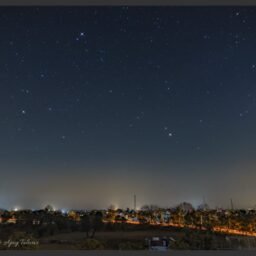
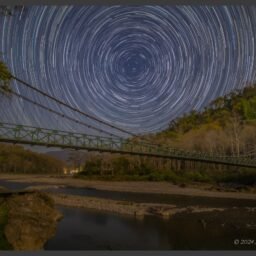

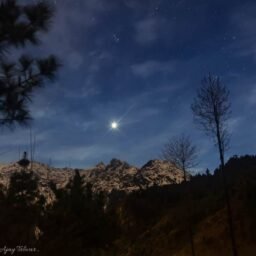

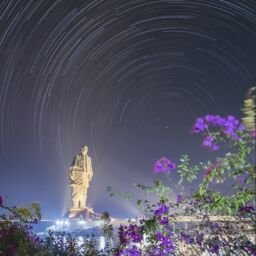

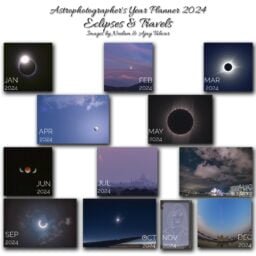
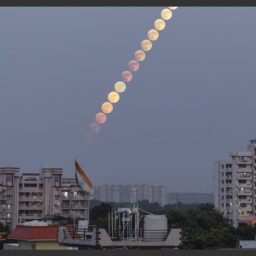

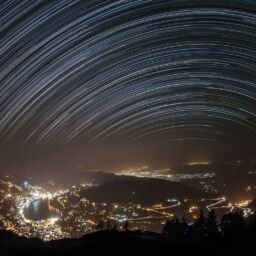
Great! Almost a heartfelt poem of the night sky. Can’t wait to go there at least once.